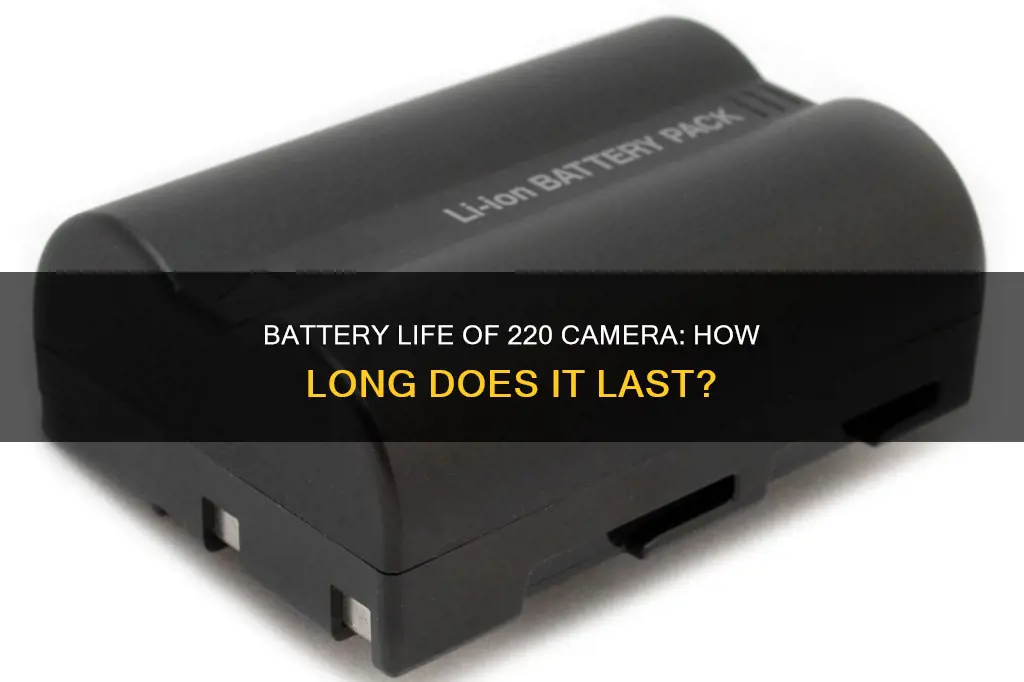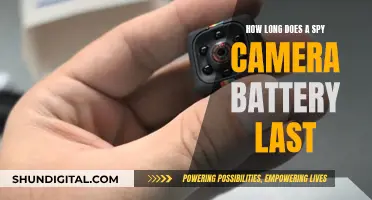
The battery life of a camera is influenced by several factors, including usage, settings, and the working environment. For example, continuous video recording, motion detection, and night vision features can drain a battery more quickly. Additionally, battery life is dependent on the type of battery and its capacity. Lithium-ion batteries, for instance, can be charged between 300 and 500 times, while nickel-metal hydride batteries can last up to 1000 charges. On average, a camera battery can last anywhere from a few months to a few years before requiring replacement.
What You'll Learn
- Battery life is affected by settings, usage, and environment
- Battery life is calculated by resting power draw, daytime power consumption, and nighttime power consumption
- Batteries should be stored with a mid-range charge in a cool, dry environment
- Continuous video recording consumes more power
- Battery life is shorter in cold weather

Battery life is affected by settings, usage, and environment
The battery life of a camera is affected by a multitude of factors, including settings, usage, and environment.
Settings such as continuous video recording, night vision, and motion detection can all impact how quickly a camera's battery drains. For example, cameras with motion detectors only record when motion is detected, preserving battery life. On the other hand, continuous recording will cause the battery to deplete much faster. Additionally, features like Wi-Fi, image stabilisation, and GPS can also contribute to reduced battery life.
Usage patterns also play a significant role in battery life. The number of pictures taken, the percentage of day-to-night photos, and the frequency of camera use can all influence how long a battery lasts. Cameras in high-traffic areas or those used for taking hundreds of photos per day will require more frequent charging or battery replacement.
The operating environment is another critical factor. Cold temperatures can significantly reduce battery performance, with batteries losing up to 50% of their capacity at extremely low temperatures. Additionally, exposure to elements like moisture and dust can impact a camera's longevity, making it crucial for outdoor cameras to be waterproof.
To maximise battery life, it is recommended to turn off or reduce the frequency of power-consuming settings, ensure optimal camera placement to minimise unnecessary triggers, and utilise energy-saving features like 'people-only' detection. Regularly charging batteries and storing them at a mid-range charge can also help maintain their longevity.
Charging Camera Pens: A Quick Guide to Powering Up Discreetly
You may want to see also

Battery life is calculated by resting power draw, daytime power consumption, and nighttime power consumption
When it comes to trail and wildlife cameras, it can be challenging to estimate their battery life. Several variables come into play, including the number of pictures taken, the percentage of day-to-night photos, temperature, and the unique power consumption characteristics of each camera. However, a good way to calculate the battery life of a camera is by considering the resting power draw, daytime power consumption, and nighttime power consumption.
The formula for calculating battery life is:
> Battery life = Capacity / Consumption x (1 - Discharge safety)
Here's a breakdown of the components:
- Capacity refers to the capacity of your battery, typically measured in ampere-hours. This value is usually printed on the battery.
- Consumption is the average current drawn by your device, expressed in amperes.
- Discharge safety is the percentage of your battery capacity that you never use. For example, with a LiPo battery used for a drone, you shouldn't discharge it below 20% to avoid potential damage.
Additionally, when calculating battery life, it's worth noting that different types of batteries have different lifespans. Lithium-ion (Li-ion) and Lithium Polymer (LiPo) batteries use one cell, whereas nickel-metal hydride (NiMH) batteries use two cells in series to double their voltage. This variation in chemistry results in different lifespans, with each type of battery requiring a unique watt-hour rating.
Moreover, the battery life of a camera is influenced by various factors, such as the settings, usage, and working environment. Batteries also tend to lose capacity over time with repeated use, which is a typical characteristic of lithium batteries.
In summary, by taking into account the resting power draw, daytime power consumption, and nighttime power consumption, you can gain a good understanding of a camera's battery life. This calculation is particularly relevant for trail and wildlife cameras, where numerous variables can impact how long the batteries last.
Charging the Wyze Camera: Quick and Easy Steps
You may want to see also

Batteries should be stored with a mid-range charge in a cool, dry environment
The battery life of a camera depends on several factors, including the camera model, usage, temperature, and settings. For example, the battery life of a Canon camera can vary from 400 photographs to 8-10 hours on a full charge.
To ensure your batteries remain in good condition, it is important to store them correctly. Here are some tips to help you prolong the life of your batteries:
Store Batteries in a Cool, Dry Environment
Avoid storing batteries in hot or humid environments. Extreme temperatures, whether hot or cold, can damage batteries. According to Rayovac, a battery manufacturer, heat over 85ºF (29.4ºC) can shorten battery life and power delivery. Therefore, it is best to avoid storing batteries in places like attics, garages, or cars, especially in warm climates. Instead, opt for a dry, climate-controlled storage space at room temperature or slightly cooler.
Store Batteries with a Mid-Range Charge
For rechargeable lithium-ion batteries, it is best to store them with a partial charge. Avoid letting the battery deplete entirely before storage, and aim to keep them charged at around 40% capacity. This will help maintain the battery's health and ensure it doesn't lose its charge over time.
Additional Tips for Storing Batteries
- Keep batteries in their original packaging or a designated battery storage container.
- Ensure batteries do not come into contact with metal objects or other batteries, as this can cause short-circuiting and leakage.
- Separate old and new batteries to prevent energy drain and potential damage.
- Do not store batteries in plastic bags or the refrigerator, as condensation can form and damage the batteries.
- Keep batteries away from direct sunlight and heat sources, as intense heat can cause the fluid in the battery to evaporate.
The Ultimate Guide to Camera Battery Chargers and Converters
You may want to see also

Continuous video recording consumes more power
The battery life of a camera is influenced by a multitude of factors, including the camera model, usage, temperature, and settings. One significant factor is the type of activity the camera is used for, such as continuous video recording. Continuous video recording consumes more power and can deplete the battery faster compared to other camera functions.
Continuous video recording requires constant power to capture and process footage, which results in higher energy consumption. The camera's processor and other components are actively engaged during recording, drawing a steady stream of power. Additionally, factors such as resolution, frame rate, and the use of additional features like IR illumination or pan-tilt can further increase power consumption.
The impact of continuous video recording on battery life is particularly noticeable when compared to still photography. Taking photographs intermittently allows the camera to enter a low-power state between shots, conserving battery. In contrast, continuous recording sustains a high level of power usage without these intervals of reduced power consumption.
To optimize battery life during continuous video recording, several strategies can be employed. Firstly, using a power bank or connecting to a power source can ensure uninterrupted recording. Additionally, adjusting camera settings, such as lowering the resolution or frame rate, can reduce power consumption. Employing motion detection features, which activate recording only when motion is sensed, can also help extend battery life.
It is worth noting that different camera models and types will have varying battery lives when used for continuous video recording. For instance, a camera with a higher-capacity battery may offer a longer recording time. Additionally, the environment and temperature can play a role, with colder temperatures typically reducing battery performance.
Charging Camera Batteries: A Quick Guide to Powering Up
You may want to see also

Battery life is shorter in cold weather
The life of a camera battery is influenced by a variety of factors, including the type of battery, how often it is used, and the temperature of its surroundings. While extreme heat can be damaging to batteries, cold temperatures can also have a significant impact on their performance and lifespan.
Cold batteries tend to discharge faster than those at room temperature or warmer. This is primarily due to the slowing or stopping of the chemical reactions that occur within the battery, which are necessary for the generation of electric current. Lower temperatures cause these reactions to proceed at a slower rate, resulting in a reduced current output. As a consequence, cold batteries quickly reach a point where they are unable to deliver sufficient current to meet the demands of the device, leading to a faster drop in battery life.
The impact of cold on battery life can vary depending on the design and chemistry of the battery. Some batteries may be more susceptible to temperature changes, while others may be better insulated and less affected. Additionally, the rate at which the device draws current can also play a role, with lower-powered devices being less affected by temperature.
To mitigate the effects of cold weather on camera battery life, it is advisable to keep batteries warm just prior to use. For smaller batteries, such as those used in cameras, storing them in a pocket close to your body heat can help maintain their warmth. This will ensure that the battery can deliver the required current and prolong its lifespan.
By understanding the impact of temperature on battery life, photographers and camera users can take proactive steps to ensure their batteries remain functional in cold weather conditions. Keeping spare batteries warm and protected from the cold can help prevent unexpected battery drain and ensure uninterrupted use of their camera equipment.
Spy Cameras: How Long Does the Charge Last?
You may want to see also







